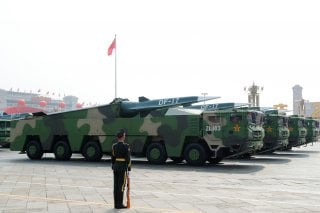Can China's Hypersonic DF-17 Missiles Threaten Taiwan? Or U.S. Bases?
Putting hypersonic missiles in these kinds of strategic positions may simply be geopolitical posturing, in part designed to test the waters and see what kind of rhetoric emerges from the U.S. regarding a possible response to a Chinese invasion of Taiwan.
Here's What You Need to Remember: One possible interpretation of China’s posturing and potential preparations is that Chinese military leaders may believe they currently have an advantage over U.S. forces, something they might want to exploit before it erodes.
China is moving hypersonic missiles to its Southern coast as part of a visible move to demonstrate resolve to potentially invade Taiwan, a prospect increasingly becoming more realistic by virtue of stepped-up exercises, bomber patrols, war games and accelerated modernization.
China’s most advanced hypersonic missile, the DF-17, is reported by the South China Morning Post to be deployed along the Southeastern coastline of China in what could be a signal or preparation for an attempt to reunite with Taiwan by force.
Interestingly, a report in the Chinese-government backed Global Times says the hypersonic weapon would be intended to thwart “foreign intruders” seeking to intervene and stop a Chinese invasion of Taiwan.
“The DF-17 is not for the use on Taiwan-based targets, since the close distance between the island and the mainland makes the bombing mission against Taiwan military targets very easy, and the advanced missiles like DF-17, if being deployed, are meant for targeting the more powerful enemies that try to intervene in the Taiwan question during the PLA's operation.”
The paper goes on to say that Chinese rocket launchers and air-launched missiles can easily reach Taiwan, making it possible to use the hypersonic weapon against major power rivals likely to defend Taiwan, such as the U.S.
“If the PLA deploys missiles like the DF-17, that would be a weapon for striking foreign military force's military bases or fleets in the West Pacific region if those 'foreign forces' dare to intervene in the PLA operation to reunify the island,” the Global Times states, citing a military expert.
One possible interpretation of China’s posturing and potential preparations is that Chinese military leaders may believe they currently have an advantage over U.S. forces, something they might want to exploit before it erodes. For instance, China now has a larger Navy than the U.S. and may have an advantage in the area of anti-satellite weapons and hypersonics.
Such a window, if it even exists, is closing quickly. The U.S. is already successfully testing and developing several hypersonic weapons expected to become operational over just the next few years. The Pentagon is also moving quickly on plans to accelerate its own massive Naval expansion, potentially even building a 500-ship Navy. Also, the U.S. is adding large numbers of faster, lower-altitude, and well-networked Low Earth Orbit satellites to build in redundancy, find ground targets more quickly and prepare for space war with stronger ASAT defenses and the hardening of networks.
Several of these ongoing initiatives will more fully take the shape of deployable, war-ready assets merely a few years from now, creating a current scenario which the Chinese may wish to exploit. At the same time, putting hypersonic missiles in these kinds of strategic positions may simply be geopolitical posturing, in part designed to test the waters and see what kind of rhetoric emerges from the U.S. regarding a possible response to a Chinese invasion of Taiwan. Then there is also the psychological warfare aspect of a maneuver of this kind, potentially suggesting that China is maneuvering weapons of this kind as part of an effort to deter or “intimidate” the U.S. through a show of force.
Kris Osborn is the new Defense Editor for the National Interest. Osborn previously served at the Pentagon as a Highly Qualified Expert with the Office of the Assistant Secretary of the Army—Acquisition, Logistics & Technology. Osborn has also worked as an anchor and on-air military specialist at national TV networks. He has appeared as a guest military expert on Fox News, MSNBC, The Military Channel, and The History Channel. He also has a Masters Degree in Comparative Literature from Columbia University.
Image: Military vehicles carrying hypersonic missiles DF-17 drive past Tiananmen Square during the military parade marking the 70th founding anniversary of People's Republic of China, on its National Day in Beijing, China October 1, 2019. REUTERS/Thomas Peter.

